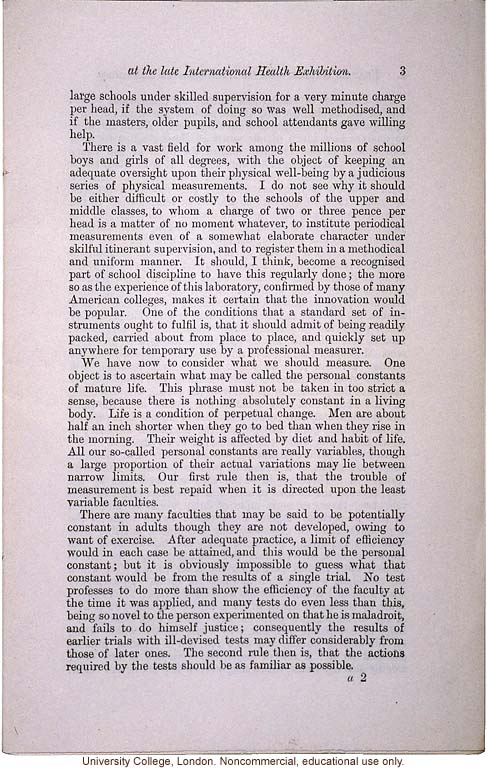at the late International Health Exhibition. 3
large schools under skilled supervision for a very minute charge per head, if the system of doing so was well methodised, and if the masters, older pupils, and school attendants gave willing help.
There is a vast field for work among the millions of school boys and girls of all degrees, with the object of keeping an adequate oversight upon their physical well-being by a judicious series of physical measurements. I do not see why it should be either difficult or costly to the schools of the upper and middle classes, to whom a charge of two or three pence per head is a matter of no moment whatever, to institute periodical measurements even of a somewhat elaborate character under skilful itinerant supervision, and to register them in a methodical and uniform manner. It should, I think, become a recognised part of school discipline to have this regularly done; the more so as the experience of this laboratory, confirmed by those of many American colleges, makes it certain that the innovation would be popular. One of the conditions that a standard set of instruments out to fulfil is, that it should admit of being readily packed, carried about from place to place, and quickly set up anywhere for temporary use by a professional measurer.
We have now to consider what we should measure. One object is to ascertain what may be called the personal constants of mature life. This phrase must not be taken in too strict a sense, because there is nothing absolutely constant in a living body. Life is a condition of perpetual change. Men are about a half an inch shorter when they go to bed than when they rise in the morning. Their weight is affected by diet and habit of life. All our so-called personal constants are really variables, though a large proportion of their actual variations may lie between narrow limits. Our first rule then is, that the trouble of measurement is best repaid when it is directed upon the lease variable faculties.
There are many faculties that may be said to be potentially constant in adults though they are not developed, owing to want of exercise. After adequate practice, a limit of efficiency would in each case be attained, and this would be the personal constant; but it is obviously impossible to guess what that constant would be from the results of a single trial. No test professes to do more than show the efficiency of the faculty at the time it was applied, and many tests do even less than this, being so novel to the person experimented on that he is maladroit, and fails to do himself justice; consequently the results of earlier trials with ill-devised tests may differ considerably from those of later ones. The second rule then is, that the actions required by the tests should be as familiar as possible.
[italics]a[end italics]2
[end]


